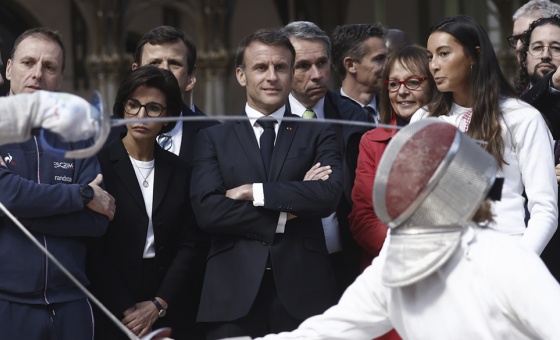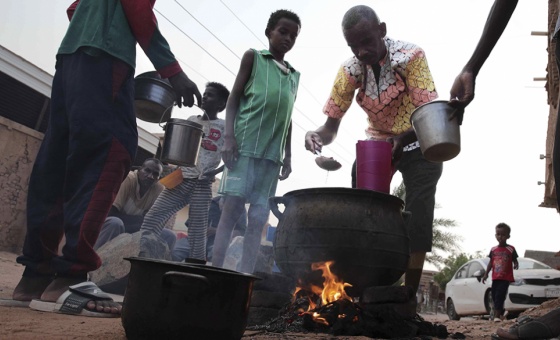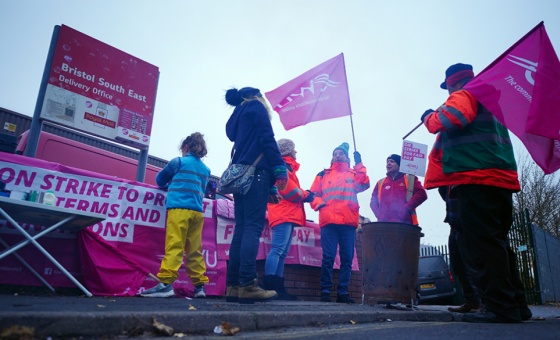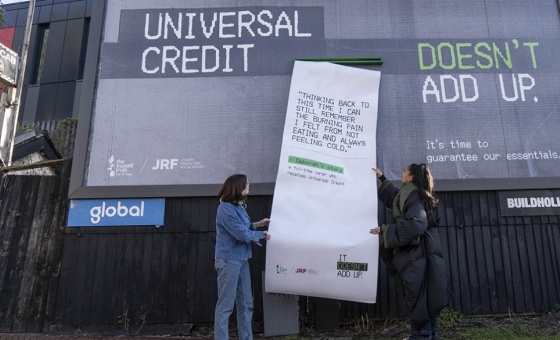This is the last article you can read this month
You can read more article this month
You can read more articles this month
Sorry your limit is up for this month
Reset on:
Please help support the Morning Star by subscribing here
MRS BANKS in Mary Poppins has a lot to answer for. The wacky, well-off Edwardian mother and employer of the magical nanny, we saw her pop out for a bit of suffragetting as her modern “yummy mummy” counterpart might a hot yoga class.
The impression was that suffragettes were a bit silly — white, privileged, slightly irrational about their cause.
Mrs Banks was, in fact, the end product of the Establishment’s long-term approach to radical women which was — if it couldn’t ignore them — to belittle, demonise or imprison them.
Most suffragettes were not eccentric privileged white ladies inexplicably chaining themselves to railings. This was a diverse movement, encompassing activists who were Indian, teenaged, working-class, disabled, socialist and all regarded as enemies of the state and treated accordingly.
Well before the advent of the suffragettes, the original, pejorative name given to members of the Women’s Social Political Union (WSPU) founded in 1903 by Emmeline Pankhurst and others, working-class women — Lancashire mill workers, in particular — were prominent in the National Union of Women’s Suffrage Societies.
WSPU leaders Hannah Mitchell and Annie Kenney had been a seamstress and mill worker respectively and hundreds of thousands of working-class women either joined or set up their own WSPU branches.
Another myth is that the suffragettes’ militant tactics were violent and so disproportionately so that they actually held back the granting of the vote. It was women’s war work what won it, runs this canard.
The truth is that the only untrammelled violence seen during the campaign came from the state.
In 1907, mounted police charged suffragettes leaving a meeting in London. Women were arrested and the next day at Westminster police court, according to the Daily Mirror, “women were kicked and struck and trampled under horses’ hooves.”
Campaigning the same year, Pankhurst and fellow WSPU member Nellie Martel were beaten up by a group of men. Pankhurst recalled: “They beat Nellie over the back of the head with their fists.” She herself was punched to the ground and limped for weeks afterwards, but resumed campaigning immediately.
At a meeting in the Albert Hall in 1908, 25-year-old Helen Ogston was attacked by two men, one of whom burnt her wrist with his cigar. The other punched her breast.
As she tried to escape them, she was assaulted by multiple men. Gangs eventually attacked every woman in sight and Pankhurst described women after the meeting as “bruised, clothes torn, false teeth knocked out, eyed swollen, noses bleeding.”
In 1910 on what became known as Black Friday, sexual violence was employed on a mass scale.
Three hundred WSPU members who marched to Parliament in protest, including Princess Sophia Duleep Singh, one of many Indian suffragettes, 200 of them were beaten and assaulted for hours, with police targeting their breasts and lifting their skirts, making sure the crowds could see the abuse.
Georgiana Solomon, widow of South African politician Saul Solomon, was 66 at the time and unable to speak about what had happened to her for a month.
Eventually, overcoming her humiliation, she revealed: “I was gripped by the breasts — by no means an exceptional act — younger women were also assaulted in this and other repellent ‘ways’.”
WSPU member Jessie Stephenson remembered: “For hours I was beaten about the body, thrown backwards and forwards from one to another until I one felt dazed by the horror of it.”
She added that she was “pushed helplessly by [my] tormentor into a side street . ..he beat up and down [my] spine until a cramp seized my legs. ‘I will teach you a lesson … I will punish you, you____, you’.”
May Billinghurst, a disabled suffragette, was thrown out of her wheelchair by police and attacked, then forced into a side street where a gang of men awaited her. The police removed the rivets from her chair to make sure she couldn’t escape. Billinghurst faced them down with such courage that the mood turned — the men assisted her.
The indomitable Billinghurst later worked out a way to use her wheelchair as a battering ram to break police ranks.
The next day, however, The Times spoke only of the women’s unacceptable behaviour, saying the men present had “kept their tempers pretty well.” The Daily Mirror disagreed, writing about the apparent pleasure the police had taken in the violence.
The violence continued to the end of the campaign — suffragette Zelie Emerson had her skull broken by a police truncheon in Hyde Park in 1913.
Another ordeal suffragettes faced was force-feeding in prison and this could include sexual assault.
Maude Kate Smith was fed nasally and, 60 years later, still suffered nosebleeds from permanently damaged nasal cavities. Lilian Lenton suffered double pneumonia and pleurisy from food particles on her lungs.
As a WSPU leader, Sylvia Pankhurst got the brunt of rough treatment during hundreds of force-feedings.
A slight woman, she was held down by six wardresses. “The doctors came stealing in … I felt a man’s hand trying to force my mouth open. My breath was coming so quickly that I felt as if I should suffocate. I felt his fingers trying to press my lips apart … and a steel gag running around my gums. It gradually prised my jaws apart as they turned a screw. It felt like having my teeth drawn, but I resisted — I resisted. I held my poor bleeding gums down on the steel with all my strength. Soon they were trying to force the India-rubber tube down my throat.
“They got the tube down, I suppose … for at last I heard them say: ‘That's all’ and I vomited as the tube came up.
“They left me on the bed exhausted, gasping for breath and sobbing convulsively. The same thing happened in the evening, but I was too tired to fight so long.”
Incredibly, suffragettes in Holloway were even subjected to anal and vaginal “feeding” which, of course, would have served no purpose beyond sadistic sexual assault.
Suffragettes came out fighting. They set fire to letter boxes and buildings, ensuring the latter were empty first, and broke windows. They did not however, injure or sexually assault anyone.
When the vote came for some in 1918, far from being rewarded, many female war workers were actually not enfranchised. Only those over 30 with a small property qualification were.
Evidence suggests the granting of the vote was in fact delayed by war and that the government feared a return to militancy by women even more righteously angry than before, having sacrificed much for their country.
As Jessie Stephenson put it, “Governments are not philanthropists — certainly not to non-voters. They seldom give what they are not forced to.”
Women in the East End had been particularly active on the suffrage campaign and, in opposing the war long after it was fashionable to do so and beyond the point it was considered treacherous.
There is a strong likelihood some of those same women, or their relatives, would have taken part in the groundbreaking Bryant and May strike 20 years earlier.
The way “sweated” matchwomen had turned their situation around in less than two weeks of industrial action and protest, winning out over one of the country’s most powerful employers and forming the largest union of women and girls at the time, was unprecedented and not lost on other exploited workers.
In the East End, throughout the country and beyond — Ireland, Sweden, even Australia — the victory note was heard and the matchwomen’s example followed.
Hundreds of thousands took strike action and new unions were formed every week. This surge of “New Unionism” was the foundation of our modern labour movement and, by extension, the Labour Party.
Like suffragettes, the matchwomen were no strangers to violence — they were used to beatings at the hands of their foremen and met with violence from police on demonstrations. Like the suffragettes too, they came out fighting.
These were no passive, waif-like “Little Matchgirls,” but, as the matchwomen’s historian, I have been fighting a 20-year battle against another myth about that undercuts their agency and refuses to die — that they were little more than the passive puppets of middle-class Fabian socialists like Annie Besant who have been credited with “leading” the strike.
Among the people who clearly and repeatedly denied this was Besant herself, who thought striking was a terrible idea yet has been memorialised by many as the strike’s “leader.”
As with the suffragettes, the unwillingness to accept that working-class women could be truly and effectively political has led to the truth being warped in ways that matter. Girls and women need their historical role models every bit as much as men do, if not more. If, as they say, you can’t see it, it’s hard to be it.
We might expect this to be a problem of the past, but the desire to allow only the “right” type of heroines to make the grade has been visible too in coverage of the #MeToo campaign.
When I ask school pupils about it, most think it was begun last year by movie stars — and unquestionably brave women — like Alyssa Milano and Rose McGowan who spoke out about sexual assault.
And no wonder when this is the story the media overwhelmingly prefers and the only one most adults have heard too.
In fact, the movement was begun not in 2017 but 2006 and not by a white movie star but by US woman of colour and political activist Tanara Burke, who had been sexually abused herself and became the conduit for victims reclaiming their voices and power.
If we look beyond the mainstream narrative, beyond celebrities and “great individuals,” we will find not one or two but literally thousands of stories of extraordinary “ordinary” women who have changed the world.
Small wonder those in power don’t favour a history which demonstrates that “working-class sheroes” can be radical, unstoppable agents of change — all the more reason why we should.
Dr Louise Raw is a historian, broadcaster, author of Striking a Light (Bloomsbury) on the 1888 matchwomen’s strike, and organiser of the annual London Matchwomen’s Festival, which takes place on June 30 in Bow, featuring Michael Rosen, Shami Chakrabarti and more. See Eventbrite “Matchwomen’s Festival” for details and tickets.










